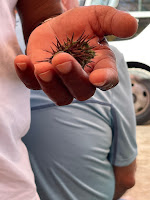Day 3 and we arrive at Grand Turk Island, BVI. It surprised us that Grand Turk, Turks and Caicos were part of the British Virgin Islands as we had always considered them to be part of the Bahamas.
 |
| Welcome to Grand Turk! |
We assembled with the rest of our group and boarded one of four buses for this tour's timeslot. Our driver was a tall, bald, black, island jolly mon named Pram. Just loading the buses we knew that Pram was going to provide a distinctive version of island color!
 |
| Beautiful Water |
The tour started out innocently enough with Pram providing historical, demographic, and socioeconomic information about the island. Right around after seeing John Glenn’s Mercury Friendship 7 space capsule (which we wondered if it wasn’t a replica) which he landed near here in 1962, Pram’s talking points started to go in a different direction.
 |
| Pram working the crowd |
It started when we came across some donkeys which now roam the island after being released from their salt-hauling duties years ago when the salt flats were closed. Pram started describing how healthy donkey meat was and how it was processed and eaten by peoples around the world. Next he started to list all the medicinal properties from the leaves of a roadside shrub and how he drank a daily concoction of four components which included these leaves which “keep me full of energy and me woman happy. Yeah, Poppa!” Then he launched into a dissertation about how Canadians eat horsemeat and how they raise the horses and process them into stakes and salami.
 |
| Meet Mr. Conch |
Then he spotted another shrub with medicinal properties and described how it could be made into a “pill” and what it was good for. Lord help us when we next drove past a large lot of goats! At this point some riders had mouths agape in disbelief, some were squinty-eyed and cringing, and some were shaking uncontrollably with laughter.
But the most bizarre part of the tour was when the bus came upon a mud-packed road that Pram backed the bus onto and into a thicket of scrubby trees for about 60 yards.
 |
| The medicinal jellyfish |
Visions of a machete attack and cannibalism came into view until we came to a small clearing with wooden benches. We all exited the bus and took seats for our next medicinal lecture. Conch shells lined the perimeter of this classroom and Pram started describing how conch meat was extracted and processed for many of the island seafood dishes. Then he went behind some trees and emerged with a live conch to show the animal inside its shell. Getting medical again, he then produced a jellyfish and a sea urchin.
 |
| " "Bush Viagara" |
He talked about the medicinal powers of jellyfish and how it can be made into a “pill.” As for the sea urchin he noted its powers when made into a powder and used to increase fertility. As proof he cited two island men in their 90s with 18 and 26 children respectively. How could it be anything else? He showed us a sea cucumber that they use to make sushi.
 |
| Mmmm...mouthwatering sushi! |
Finally, he lectured us on how baby sea turtle blood can be used to treat convulsions in children and babies, but he didn’t back this up with any controlled clinical study. The hardest thing for Capt. Larry to swallow was Pram’s claim that modern pharmacies only arrived on the island in the last 10 years (around 2012) and that people still clung to “bush medicine”— implying that modern ways haven’t taken hold. While these stories are entertaining and help fill the tip jar they should be taken with a grain of salt. But we do wonder about that horsemeat salami the Canadians make!
We decided to forgo the beach experience with the little remaining time we had, so we returned to our ship and finished out the day with a nap, dinner, and a musical show about boy bands (yes, I said boy bands!).
 |
| Grand Turk Island Lighthouse |

No comments:
Post a Comment